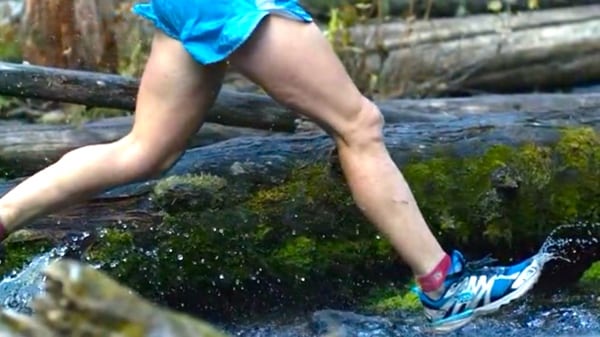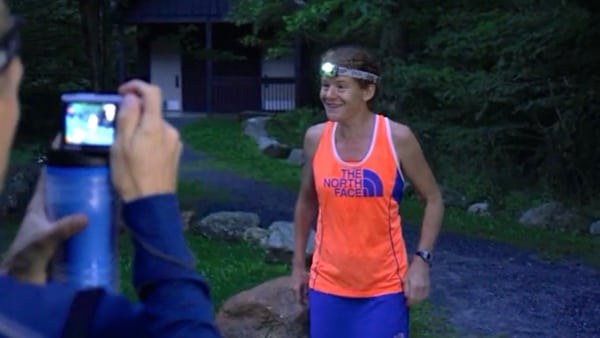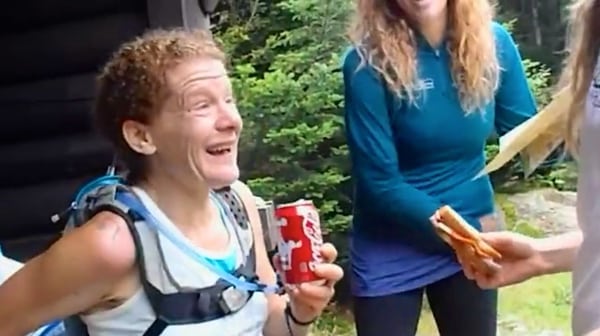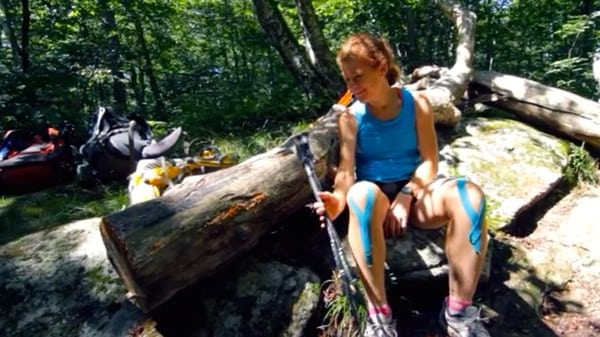 In the summer of 2013, Nikki Kimball re-set the women’s speed record to five days, seven hours, and 42 minutes on Vermont’s Long Trail, a 272-mile trail that runs north-to-south through the state, between the Canadian and Massachusetts borders. Finding Traction is a 56-minute film produced and directed by Jaime Jacobsen documenting Nikki’s record attempt and exploring the aspects of her personality and life history that led to this undertaking.
In the summer of 2013, Nikki Kimball re-set the women’s speed record to five days, seven hours, and 42 minutes on Vermont’s Long Trail, a 272-mile trail that runs north-to-south through the state, between the Canadian and Massachusetts borders. Finding Traction is a 56-minute film produced and directed by Jaime Jacobsen documenting Nikki’s record attempt and exploring the aspects of her personality and life history that led to this undertaking.
I’d like to preface this review by explaining that I have a strong personal bias toward Nikki. I’ve known about and been a fan of hers for quite a long time. More than a decade ago, when I was running some of my first trail races and Nikki was in the peak of her ultra career, we were living about an hour apart from each other, she in Montana and me over the border in Wyoming. We met ever-so-briefly while waiting in a porta-potty line at the start of a tiny 5k trail race outside of Butte, Montana. After meeting her, I followed her running trajectory eagerly, sponging from it some of the knowledge and inspiration I needed to get going on my own. In the intervening time since then, Nikki and I have become friends who keep in touch with email exchanges and catch-ups at races. Last year, we shared an intimate experience when she allowed me to write about her life-long struggle with depression for a Trail Runner magazine story called ‘The Hope Seekers.’ We are, thus, connected by more than just the one degree of separation that is the global trail running community today, and I find much inspiration in who Nikki is, what she stands for, and how she lives her life.
Don’t kid yourself into thinking that your hour with Finding Traction will be overarchingly uplifting. Even though I share a personal relationship with Nikki and I, thus, had an idea of what I was getting myself into with Finding Traction, the film still kicked my emotional ass and I’m pretty sure it will yours, too. At times, you’d kind of like to slide down out of your chair and slink from the room because the demons living inside of Nikki are protagonists to her story as much as she is. I don’t mean to say that there isn’t indelible joy in this film, either, or that you never see Nikki experiencing it. But Nikki’s happiness comes part and parcel to her pain, and sometimes she transmits these celebratory emotions right before or after an explosion of agony. You walk away from this film feeling both the weight of her record-breaking achievement’s effort and the fact that Nikki lives, at times, very close to feelings of sadness and pain.

Nikki Kimball during her Long Trail speed record attempt. All photos are screenshots from Finding Traction.
The rawness and honesty that make Finding Traction difficult to watch are also what make it shine. This film is, quite literally, a mirror of Nikki. The way she thinks, her approach to life, her deepest motivations, her tools for coexistence with a sometimes-challenging psyche, her tolerance for suffering, her no-nonsense mannerisms, the way that even she can almost crack apart under enough difficulty, the relief of achievement, the imperfection of body and soul, the tears, Nikki’s intense eyes, the physical distresses that accompany efforts of this sort, the accomplishment itself, it’s all there. In my opinion, filmmaker Jaime Jacobsen really nails it in this respect: Nikki herself is manifested in Finding Traction’s plot, the optical and mechanical effects imposed on the filming and post-production processes, camera angles, voice-over narration, musical arrangement and sometimes syncopation, and more. What I’m trying to say is that the film doesn’t so much tell a story, as much as it simply just is Nikki.
There’s a trend in outdoor filmmaking right now, in my opinion, that glamorizes what athletes do. Athletes and their efforts are portrayed with abundant aesthetic. But trail running, for instance, can also be quite the opposite, visually. We get nasty blisters and wounds on our feet, we puff up on pounds of water weight, our souls grow dark under our efforts, our fingernails become caked with dirt, we are rubbed raw by chafing, we have cellulite, we cry because we can’t bear the pain, we vomit, our clothes become filthy, and we have problematic gear failures. These are the realities of our sport, but this sort of reality doesn’t play so well on film, so filmmakers often make these great leaps and sidesteps to avoid them. When that happens, what we do is reduced to visions of our muscular, lean bodies grazing the depths of big, wild landscapes. I love the fact that nothing gets swept under the rug in Finding Traction, and I thank Jaime Jacobsen for capturing the fact that the grace of our sport evolves out of moments that are aesthetically balanced as well as those that aren’t.
Slow-Motion Scene Play
The film begins with a slow-motion scene of Nikki running through a stream, her curly hair flying, water droplets squishing this way and that, and her eyes focused on where each foot falls. She is a vision of living in the moment. This slo-mo style returns several times, often enough that you realize the director is trying to convey meaning with it. About halfway through the film, we learn that meaning: Nikki says in a voice-over narration of a slo-mo scene, “…In doing things like this, it’s not always easy or comfortable. I’m in a lot of pain, but that’s when time stops… When you feel that intense and exquisite pain, everything else melts away.” We, as viewers, are meant to live those moments as Nikki does, with time slowing and everything but her motion disappearing. These speed change-ups are beautiful inherently, but once you know Jaime’s intent with them, they become even more so.

The slow-motion opening scene.
No Holds Barred
The no-holds-barred, function-over-form, matter-of-fact nature of Nikki’s personality is not so subtly on display in the film. From start to finish, Nikki presents herself and is presented by the film as just who she is, no more, no less. Since we live in a culture where social constructs attempt to persuade us into being polite instead of honest, Nikki’s take on life is refreshing. No, she’s never rude or mean. I’m talking about a woman who simply implies with her actions, I am what I am. Take me or leave me.
A playful example of this is her clothing choice for the second day of her attempt, a skirt. Throughout the day, her skirt, however, seems to disappear, and she wears orange hot pants in some of the scenes. At first, I wonder if there is a problematic edit of another day’s footage into day two, but then I realize that her skirt was simply hiked up around her waist and it was the built-in shorts of the skirt that we are seeing. Who knows why Nikki does this, maybe to cool herself off or to offer more mobility on the really steep terrain? It’s a silly, tiny detail, I realize, but I love it because it represents Nikki’s take-me-as-I-am approach.

Nikki on the morning of day two.
The Truth Sets You Free
You observe Nikki’s honesty over and over, literally dozens of moments where she acts and speaks in ways that are, at times, brutal for the way she pinpoints our culture’s issues and beautiful for the way she gets exactly, precisely to her point. Here are a few quotes to show you what I mean:
- “When I see high school kids with low back pain because they’re too fat, that’s a problem.”
- “Just because I have ovaries, I’m not getting paid as well.”
- “Something I wish I could tell everyone looking down the barrel of a gun [because of depression]: You will find happiness again, you can.”
- “I want my aggressiveness and stubbornness to be seen as good qualities, not as bad qualities. Not, ‘Oh well she’s aggressive and competitive, so she’s a bitch.’ I want to see, ‘Oh she’s aggressive and competitive, so she’s successful.'”
Acknowledging the Aging Process
We watch Nikki tackle some of the Long Trail’s very technical terrain daintily and awkwardly, especially the downhills. We hear her say that, when she was at her prime, no one passed her on the downhills, and that she has to descend slowly in this record effort in order to save her knees. At one point, this frustrates her to the point of tears, and she eventually blames her inability to descend efficiently on why she can’t complete the Long Trail faster than the men’s speed record. In some parts of the film, you see Nikki accept aging as an unavoidable fact. In others, you see her mourning her changing skills and abilities. The overall treatment of this theme is that Nikki is deeply in the throes of acknowledging the aging process, and it’s a theme I know will resonate with many viewers.
Contemplations on Depression
Over the course of the film, Nikki explains her complicated, intertwining relationship with her depression. She says that her running has saved her from it by giving her a means to cope. We also learn that her depression has been fuel for her ultrarunning fire. Nikki says, “I think that depression is my secret weapon. When things get bad in an expedition or an ultra race, I can look back to the worst pain I was in during my depression, and the pain I’m in at an ultra race isn’t that bad… That was a very tough part of my life, living through not wanting to live… When you’re depressed, you feel nothing. The highest highs and lowest lows of ultras juxtaposed is amazing.”
Jaime does a lovely job of peppering these contemplations about depression as narrations to scenes showing Nikki suffering quite a lot to get through her record attempt and, at least once, saying she really wants to quit. As an outside viewer to documented physical feats like this one, it’s often a challenge to tangibly extract how much a moment can hurt. We intellectually understand that there must be pain, but that understanding is intangible. Jaime’s use of narration here brings the viewer to the ground level with Nikki. Such close exposure stings my soul and brings tears to my eyes, but it also brings the viewer to the heart of what drives Nikki to run, and to live.
The Irrationality of the Human Mind Under Duress
There’s an endearing scene from late in her effort where Nikki is at a crew stop, eating a sandwich and sipping off a Coke. At one second, she’s a bit like a toddler, her eyes creased shut, sobbing, shoulders shaking. The viewer never quite knows why, but you can feel Nikki’s duress. Moments later, she breaks into hysterical laughter at a trivial, goofy exchange among her crew members. Humans get irrational when they get tired and Nikki is no different. The scene will make you belly laugh.

Laughter moments after a good cry.
Standing Up for Women
Women in sports is a strong theme throughout the film. Nikki tells viewers, “Women need to take their place in sports and show that we are worth watching.”
We learn that Nikki believes women get the short end of the sporting stick, including in trail running. She relays a frustrating story from her win of the 2007 Ultra-Trail du Mont-Blanc. She explains, the male winner got loads of face time in the local newspaper the day after, and so did the rest of top male finishers. She was mentioned only in passing, she says.
We watch for the first four days as Nikki goes after the men’s speed record, not the women’s. Ultimately, the stars of fitness and weather don’t align and she misses that goal, wherein she switches to bettering the women’s speed record. About her first goal, she says, “I’m not going for the men’s record just to go for it. Women need to take ownership of their dreams… I’d like to see women pursuing very hard goals.”
During the film, we learn that Nikki is fundraising for Girls on the Run, a non-profit aiming to create communities of active girls. On day five, Nikki is visited by Lauren Henry from Girls on the Run Vermont, who thanks Nikki for the work she is doing to give voice to women’s athletics and to raise money for her organization. I won’t spoil the scene, but let’s call it emotionally charged, and just lovely.
The film ends on this theme as well, with footage of her completing the Long Trail along with a clips and narration from an interview conducted after the fact enough that she has some perspective on her effort but recent enough that she’s still quite emotionally charged. We watch her powerhiking to the finish, her eyes searching for the end of the trail, her body leaning toward it. We also see her in that interview, her eyes red and glistening with tears, her eye contact breaking to look down now and again, her vulnerability and power both on display. She says, “I think too many girls are taught to allow fear to limit their actions. I want girls to explore their fears and to crush them… If I help just one person realize she’s capable of so much more than her fears, I want her to know this expedition has been a success.” We see Nikki come to rest at the end of the Long Trail, smiling with relief, successfully setting a new women’s speed record.

Nikki tells viewers she wants her record to inspire women.
It is via this last scene that the viewer realizes Finding Traction is more about the way Nikki has found purchase with life than it is about her Long Trail record attempt. Nikki, you’ve gotta’ know, your life and your record attempt are a success. You inspire the heck out of so many people, me included. Thank you for that.

Nikki completes the Long Trail with a new women’s speed record.
How to Watch Finding Traction
Live Screenings:
Finding Traction is a part of the 2015 Trails in Motion trail running film tour, will be screened at several documentary-film festivals around the world this year, and will be played a couple times on a Montana PBS station. Here is a list of live and TV screenings for the next couple of months:
- February 6, 2 p.m. – Rotorua, New Zealand, screening is part of the Trails in Motion tour shown at the Tarawera Ultramarathon Expo
- February 7, 6 p.m. – Campbell, California, USA, screening is part of the Trails in Motion tour at Road Runner Sports
- February 8, 4 p.m. – Missoula, Montana, USA, screening at the Wilma as part of the Big Sky Documentary Film Festival
- February 10, 7 p.m. – Bozeman, Montana, USA, screening at the Emerson Cultural Center and is the Montana local premiere
- February 14, 7:30 p.m. – Vancouver, Canada, screening is part of the Vancouver International Mountain Film Festival
- February 17, 7 p.m. – Livingston, Montana, USA, screening is part of the Livingston Film Festival
-
February 23, 8 p.m. – Public broadcast across the state of Montana on Montana PBS/KUSM-TV
- February 25, 1 a.m. – Public broadcast across the state of Montana on Montana PBS/KUSM-TV
- March 3, 6:59 p.m. – Public broadcast across the state of Montana on Montana PBS/KUSM-TV
- March 18, time T.B.A. – Tokyo, Japan, screening is part of the Trails in Motion tour at Sakaiya Sports
- March 21, 1:15 p.m. – Sheffield, United Kingdom, screening at the Sheffield Adventure Film Festival
- March 22, 3:30 p.m. – Sheffield, United Kingdom, screening at the Sheffield Adventure Film Festival
- March 28, 12 p.m. – Montpelier, Vermont, USA, screening at the Green Mountain Film Festival
- March 29, time T.B.A. – Amsterdam, Netherlands, screening is part of the Trails in Motion tour at Lab 111
There are dozens more Trails in Motion tour dates around the world this year; check their website to find a date near you. Additional live screenings will be coming throughout the year. Watch Finding Traction’s Facebook page for more.
DVD/Online Streaming:
The film should be available on commercial DVD release and online streaming via the Montana PBS store this spring. We’ll update this section of the article when that happens, and watch Finding Traction’s Facebook page for more news.
Finding Traction Trailer
Call for Comments
- How has Nikki Kimball inspired you over the years? Do you have a specific story about how she’s pushed you to be a better version of yourself? Share your stories!
- Have you seen Finding Traction, or do you plan to see it?
